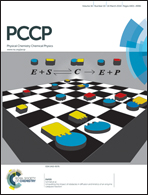Manganese hexacyanoferrate derived Mn3O4 nanocubes–reduced graphene oxide nanocomposites and their charge storage characteristics in supercapacitors
Abstract
Mn3O4–reduced graphene oxide (RGO) nanocomposites were prepared by chemical decomposition of the manganese hexacyanoferrate (MnHCF) complex directly on the graphene surface. XRD studies revealed the formation of crystalline hausmannite Mn3O4 nanocubes in the as-prepared nanocomposites without any heat treatment. The FE-SEM images showed the formation of Mn3O4 nanocubes on the graphene surface in the as-prepared nanocomposites. HR-TEM studies confirmed the homogeneous dispersion of ∼25 nm Mn3O4 nanocubes on graphene nanosheets. The amount of Mn3O4 nanocubes and graphene in the nanocomposites was estimated using TGA analysis from room temperature to 800 °C in air. The FT-IR and Raman spectroscopic analysis confirmed the functional groups in the nanocomposites and defects in graphene nanosheets in the nanocomposites. Cyclic voltammetry and galvanostatic charge–discharge experiments demonstrated a high specific capacitance of 131 F g−1 in 1 M Na2SO4 electrolyte at a current density of 0.5 A g−1 for the RGM-0.5 nanocomposite. A capacitance retention of 99% was observed for 500 charge–discharge cycles at a current density of 5 A g−1, which conformed the excellent stability of the RGM electrodes. The prepared Mn3O4–RGO nanocomposites are promising for electrochemical energy storage.


 Please wait while we load your content...
Please wait while we load your content...